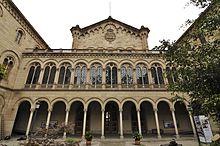University of Barcelona
Alfons el Magnànim’s prerogative, though, was granted at the petition of the Consell de Cent, and so the council was always to consider the Estudi General created in 1450 as the city's true university, since it was very much under its control and patronage.In his letter written 23 January 1398, and addressed to the councillors of Barcelona, he informed them that he had sought the Pope's permission to found a university in the city.[10] The prerogative granted by King Alphonse the Magnanimous in 1450, authorizing the Consell de Cent to found a university in Barcelona, was the culmination of the process initiated in 1398.For a number of reasons, in particular the civil war that raged during the reign of John II and the subsequent conflicts involving the peasant farmers, the official Estudi General of Barcelona did not begin to develop until the reign of Fernando the Catholic; but it was under Charles I, in 1536, that the foundation stone was laid for the new university building at the top end of La Rambla.These followed hard on the heels of earlier Ordinances passed in 1539 and 1559, in which the competitive examination system for the appointment of professors had been introduced.The inadequate nature of these premises soon gave rise to the need to construct a larger home for the University, and in 1863, work began on Elies Rogent's new building, though it would not be fully completed until 1882.Complementing the building work, sculptures and paintings were commissioned either directly from artists of repute or awarded in open competition.The natural growth of the University of Barcelona has given rise to the need to undertake large-scale building work to meet the growing demands made by student numbers that were unthinkable in the nineteenth century.





PublicRectorJoan GuàrdiaBarcelonaCatalanColoursCoimbra GroupEuropean University AssociationMediterranean Universities UnionInternational Research Universities NetworkVives NetworkSino-Spanish University Alliance (SSU)research universityCataloniaGovernment of CataloniaBarcelona Science Park Foundation (PCB)Institute of Biomedical Research of Barcelona (IRBB)Institut Barcelona d'Estudis InternacionalsElies RogentAlfons el Magnànimmedical schoolMartí of AragonConsell de CentDominicanMartí the HumaneUniversity of MontpellierValenciaJohn IIFernando the CatholicCharles ILa RamblaDuke of BerwickCerveraJesuitsUniversity of CerveraPhilip VBourbonWar of the Spanish SuccessionIsabella IIBalearic IslandsBellvitgePedralbesMontserratCampus MundetLlars MundetUniversitat Politècnica de CatalunyaUniversitat Autònoma of BarcelonaCatalunya en MiniaturaBiologyChemistryDentistryEarth SciencesFine ArtsGeographyInformation SciencesComputer SciencesPharmacyFood SciencesPhilologyPhilosophyPhysicsPsychologyBarcelona Institute of International StudiesEducation SciencesDoctoral schoolAudiovisualsPublic RelationsPhysical EducationNursingUniversity rankingsQS World University Rankings by SubjectShanghaiRanking's Global Ranking of Academic SubjectsEuropePere AragonèsArtur MasPasqual MaragallManuel CastellsLluís CompanysAda ColauJosé CarrerasPau GasolJoan LaportaPep GuardiolaManuel BallesterLourdes BeneríaRamon BerguerRoser Caminals-HeathEudald CarbonellManuel CardonaFrancesc Xavier Hernández CardonaTomás Carreras ArtauGermà ColonJoan CorominesSergio ErillCarlota Escutia DottiRichard Arnold EpsteinAlbert Folch FolchJoaquin FusterValentín FusterJuan David García BaccaEnrique García-BerroThomas F. GlickPilar González i DuarteMaria Rosa Miracle SoléOriol Martorell i CodinaManuel Milà i FontanalsJaume MoraAnthony PagdenAnna Perdrix RosellJordi Folch PiJordi PujolBegoña Román MaestreAldemaro Romero Jr.Venezuelan/AmericanAntoni Rubió i LluchJordi Sabater PiMarta SegarraXavier SerraSunny SinghMontserrat Soliva TorrentóJuan VernetMuriel Villanueva i PerarnauCurt WittlinPilar Vélez VicenteRon AriasBernardo Atxaga